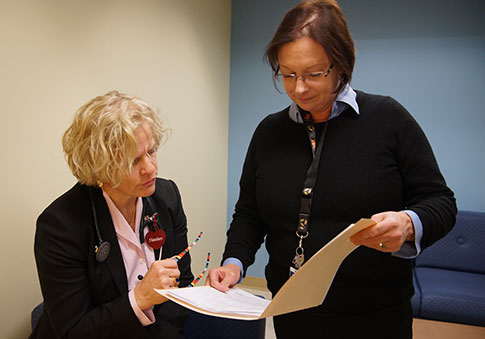
Dr. Heather Ross, cardiologist, and Jane MacIver, nurse practitioner, say initiating end-of-life discussions with cardiac patients is anything but black and white. (Photo: UHN)
Inside a small, neatly furnished private room on the fifth floor of the Peter Munk Cardiac Centre, the subject is often broached.
"When given a 50 per cent chance of dying in the next six months, the advanced heart failure patients I speak to automatically think they are in the 50 per cent who will survive," says Jane MacIver, Nurse Practitioner.
"They don't think they are going to die. There is persistent optimism," she says.
Optimism in any other circumstance is usually welcome, but against this backdrop, MacIver's job quickly escalates in complexity.
"It now becomes a question of figuring out how to communicate to the patient and their family that there are no alternatives, no last-ditch treatments to try, no new miracle waiting in the wings," she says.
The devastating reality is they are likely going to die due to a rapidly deteriorating heart. And it is only a matter of time.
"Some patients are never prepared to hear the news. But sometimes patients say, we've been waiting for you to say there is nothing else we can do for you," says Dr. Heather Ross, Cardiologist, Director of the Ted Rogers Centre of Excellence in Heart Function.
"One size does not fit all," she adds.
Beginning the conversation
Initiating end-of-life discussions with cardiac patients is anything but black and white. Incredible improvements and surprising setbacks in the medical journey of a heart failure patient are the rule, not the exception. These wide fluctuations make for an unpredictable journey for both patient and often the medical team.
"With cancer, end-of-life issues are embedded and discussed from day one," says Dr. Ross. "Not so here. Advanced heart disease patients have often been neglected when it comes to end-of-life issues," she says.
A recent review of one thousand patients admitted to four Toronto-area Palliative Care Units over a period of a year, found that 79 per cent were cancer patients, but only 4.5 per cent were heart disease patients.
Both Ross and MacIver and their team are taking proactive steps to address and change this reality. Their effort is rooted in communication.
Changing communication
The Peter Munk Cardiac Centre's Heart Failure Team is currently conducting a study to measure health literacy to better understand what and how to target communication about end-of-life issues to patients.
"Previous studies have shown many gaps in end-of-life communication. Heart failure patients want open, honest communication about their prognosis," says MacIver. "Our research is focused on talking to patients to find out when is the best time to approach them with end of life information, who is the best person to talk to them about it, when their families should be told."
"Patients often tell us the information is complex and difficult to understand. The onus is on us as medical professionals to ensure we are clearly communicating what is without question
the most difficult conversation we have with our patients," she says.
"Central to improving our communication to patients about end of life care, is understanding that end of life communication is not a single conversation, nor is it a 'do not resuscitate' conversation," says Dr. Ross.
As such, the pair is working with other centres in a study to educate physicians and medical professionals on improving their communication techniques when it comes to addressing a patient at the end of their life.
"We were never taught this in medical or nursing school," says Dr. Ross. "We are so focused on improving outcomes and survival rates, both critically important, however the idea of considering a patient will not survive rarely enters the equation."
Dr. Ross notes many of her colleagues
never use the words 'die' or 'death' when having an end-of-life conversation.
"That needs to change," says Dr. Ross. "Delivering bad news is not easy, but there is an opportunity to train new clinicians and physicians to do this and do it well."
"It is teachable. Medical professionals need to consider body language, posture, non-verbal communication, having other family members present, and the words they use when they undertake an end-of-life discussion with a patient," she says.
Dr. Heather Ross and nurse practitioner Jane MacIver have done studies in this area. Including:
Habal MV, Micevski V, Greenwood S, Delgado DH, Ross HJ.How aware of advanced care directives are heart failure patients, and are they using them? Canadian Journal of Cardiology 2011, 27; 376-381\
- There is a lack of knowledge and utilization of advance care directives among patients with heart failure.
- Patients want to discuss advance care directives
- Even when they are discussed, many patients forget having the conversation
Timmons MJ, MacIver J, Alba AC, Tibbles A, Greenwood G & Ross HJ.
Using heart failure instruments to determine when to refer heart failure patients to palliative care. Journal of Palliative Care 2013; 294: 217-224
- A standardized approach to symptom management in heart failure is needed.
- Tools used to measure symptom severity in cancer patients may be used to measure symptoms in patients with heart failure.
- Patients with persistently high symptom severity or multiple symptoms should be referred to palliative care for additional support.
Mitar M, Alba C, MacIver J & Ross HJ. "Lost in Translation":
Examining Patient and Physician Perceptions of Implantable Cardioverter Defibrillator Deactivation Discussions. Circulation: Heart Failure 2012; 5: 660-666.
- The majority of patients who discussed ICD deactivation at end of life, chose to deactivate the device.
- While many physicians consider ICD deactivation discussions important, most do not have these discussions with their patients.
- A conversational protocol may help increase the rate of ICD deactivation discussions. These strategies should be aimed at all levels to increase exposure and comfort level.
